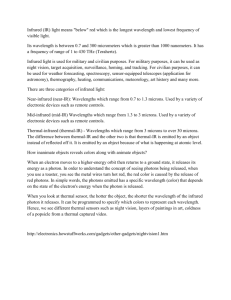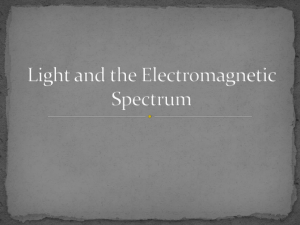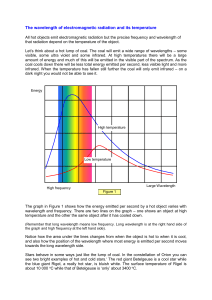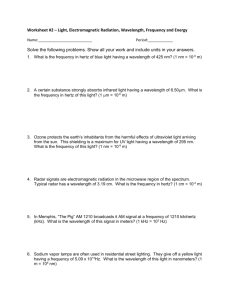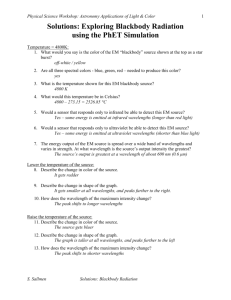The correct answers are written in bold, italic and underlined. The
advertisement
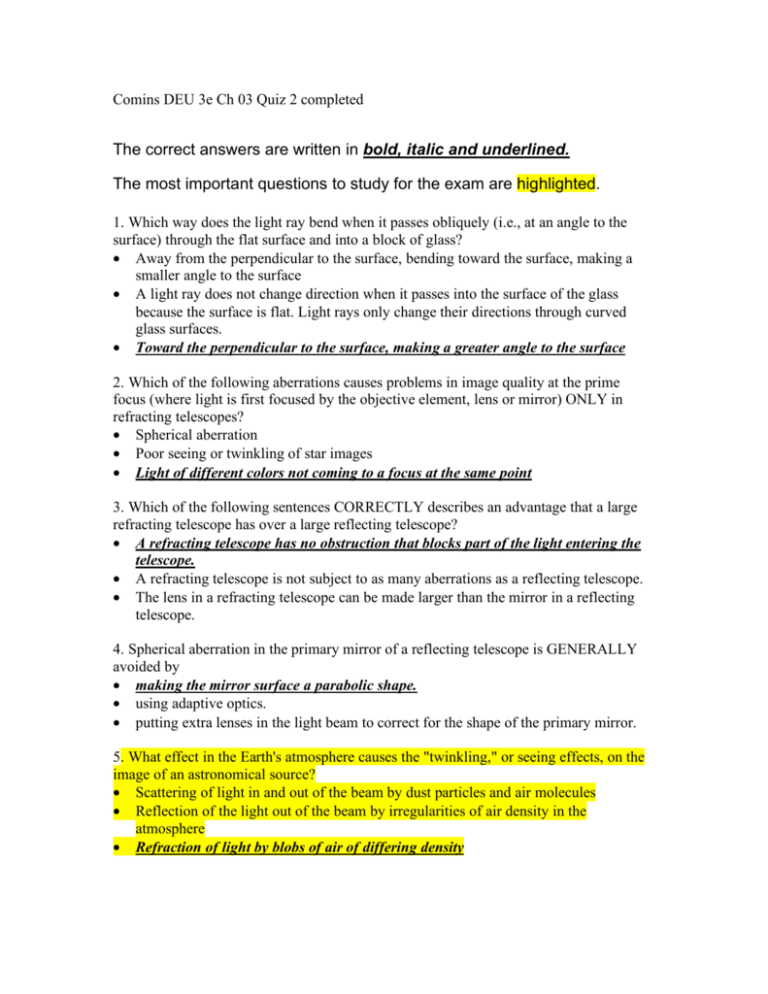
Comins DEU 3e Ch 03 Quiz 2 completed The correct answers are written in bold, italic and underlined. The most important questions to study for the exam are highlighted. 1. Which way does the light ray bend when it passes obliquely (i.e., at an angle to the surface) through the flat surface and into a block of glass? • Away from the perpendicular to the surface, bending toward the surface, making a smaller angle to the surface • A light ray does not change direction when it passes into the surface of the glass because the surface is flat. Light rays only change their directions through curved glass surfaces. • Toward the perpendicular to the surface, making a greater angle to the surface 2. Which of the following aberrations causes problems in image quality at the prime focus (where light is first focused by the objective element, lens or mirror) ONLY in refracting telescopes? • Spherical aberration • Poor seeing or twinkling of star images • Light of different colors not coming to a focus at the same point 3. Which of the following sentences CORRECTLY describes an advantage that a large refracting telescope has over a large reflecting telescope? • A refracting telescope has no obstruction that blocks part of the light entering the telescope. • A refracting telescope is not subject to as many aberrations as a reflecting telescope. • The lens in a refracting telescope can be made larger than the mirror in a reflecting telescope. 4. Spherical aberration in the primary mirror of a reflecting telescope is GENERALLY avoided by • making the mirror surface a parabolic shape. • using adaptive optics. • putting extra lenses in the light beam to correct for the shape of the primary mirror. 5. What effect in the Earth's atmosphere causes the "twinkling," or seeing effects, on the image of an astronomical source? • Scattering of light in and out of the beam by dust particles and air molecules • Reflection of the light out of the beam by irregularities of air density in the atmosphere • Refraction of light by blobs of air of differing density 6. Which of the following techniques have now produced the sharpest images of sources in the universe? • Electronic imaging on the new 10-m diameter Keck telescope on the high volcanic mountain Mauna Kea on Hawaii • Cameras on board the 2.4-m Hubble Space Telescope from above the atmosphere, in space • Combination of many radio telescopes into an interferometer 7. What is the greatest obstacle to observing the universe in the infrared region of the spectrum from an observatory on the ground? • The longer wavelengths of infrared radiation compared to those of visible light • Water vapor in the Earth's atmosphere • Seeing, i.e., the twinkling of objects seen through the Earth's atmosphere 8. To which of the following radiations is the Earth's atmosphere transparent? • X rays and gamma rays • Radio and visible light • Ultraviolet radiation 9. When a piece of steel is heated, the wavelength of peak intensity of the emitted electromagnetic radiation will • change from ultraviolet, through visible light, to infrared radiation. • change from infrared, through visible, to ultraviolet. • not change at all. The intensity of radiation increases at all wavelengths, but the peak wavelength does not change. 10. A perfect blackbody is so-called by scientists because • it absorbs all energy falling on it and emits no energy at all, hence its name. • it absorbs all energy falling upon it and emits a characteristic spectrum of radiation whose intensity as a function of wavelength depends only on the blackbody's temperature. • the spectrum of energy absorbed and emitted by it has a fixed shape as a function of wavelength, the emitted intensity alone depending on the blackbody's temperature. 11. If the temperature of a blackbody increases, the intensity of emitted energy becomes • greater at all wavelengths. • greater near the wavelength of peak emission, but unchanged at other wavelengths. • less at longer wavelengths and greater at shorter wavelengths 12. Cepheid variable stars pulsate regularly in size. During the contraction part of the cycle, when the star's temperature is increasing, the peak wavelength of the emitted radiation will • shift from the UV to the visible part of the spectrum. • remain unchanged. • shift from the visible to the UV part of the spectrum. 13. A small particle of interplanetary material is heated by friction from a temperature of 400 K to 4000 K as it falls into the atmosphere of the Earth and produces a meteor or a shooting star in our sky. If this object behaves like a perfect blackbody over this short time, how will its emitted radiation change as it is heated? • Its total intensity will rise by a factor of 10 while its peak wavelength will become shorter by a factor of 10, moving from the infrared to red visible light. • Its total emitted intensity will rise by a factor of 10,000 while its peak wavelength will become shorter by a factor of 10, moving from the infrared to red visible light. • Its total intensity will rise by a factor of 10,000 while its peak wavelength will become longer by a factor of 10, moving from visible light to the infrared or heat radiation. 14. The person who originated the idea that light is emitted and absorbed in packets of energy (later called photons by Albert Einstein) was • Max Planck, who explained the shape of the blackbody curve. • Ernest Rutherford, who discovered the atomic nucleus. • Niels Bohr, who explained the spectrum of emission or absorption lines of hydrogen in terms of electron transitions in atoms. 15. In a beam of radiation from a blackbody, the amounts of energy per second at an ultraviolet wavelength of 300 nm and at an infrared wavelength of 800 nm are found to be equal. In this beam, how do the numbers of photons per second at each of these wavelengths compare? • There will be a greater number of IR photons than UV photons. • There will be equal numbers of photons at each of these wavelengths. • There will be a greater number of UV photons than IR photons. 16. Suppose an astronomical satellite observes the Orion Nebula at a wavelength of 1250 nm. In what wavelength range is this satellite observing? • X rays • Infrared • Ultraviolet 17. Spectral lines were first discovered • by Balmer, by passing an electric current through rarified hydrogen gas and breaking the resulting light into colors using a prism. • by Fraunhofer, by passing the light from the Sun through a prism and magnifying the resulting spectrum. • by Kirchhoff, by dropping chemicals in the form of powder into a very hot flame and looking at the resulting light through a prism. 18. In 1868, astronomers observed a spectral line in the Sun at a wavelength where they had never seen a spectral line before, even in laboratory sources, although other solar spectral lines were where they were expected to be. The logical conclusion that they reached based on this observation was that • the temperature of this portion of the Sun was much higher, or possibly much lower, than anyone had ever expected. • gas in that part of the Sun was moving very rapidly toward or away from them, causing that spectral line to become Doppler-shifted to a new wavelength. • they had found a previously undiscovered element. 19. An astronomer wants to use a spectrograph to disperse the light from a star into its component colors. She has a choice between using a prism or a diffraction grating to disperse the light. Which of the following statements correctly describes an advantage of one of these choices over the other? • The prism disperses the light evenly across the spectrum, whereas the diffraction grating disperses it unevenly. • The diffraction grating disperses the light evenly at all colors, whereas the prism disperses it unevenly. • The prism reflects the light poorly, whereas the diffraction grating reflects light far better and over a wider wavelength range. 20. When heated in a flame, small quantities of different chemical elements emit light at specific wavelengths or colors called "spectral line" emissions. The pattern of these emission lines as a function of wavelength • is characteristic of each element and differs from element to element. • is the same for all elements, except that one line is missing from the sequence―a different line for each element. • is the same for all elements, but with different relative line intensities for different elements.
